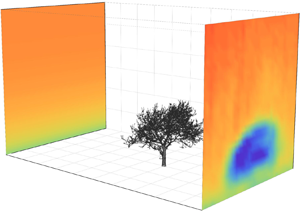Article contents
Scanning Doppler lidar measurements of drag force on a solitary tree
Published online by Cambridge University Press: 28 April 2021
Abstract

Trees are known to reduce the wind momentum efficiently. Yet, firm quantitative estimates of their contribution to the land surface drag have remained elusive, partly because trees have complex shapes that consist of elastic multi-scale elements. This structural complexity makes trees inherently difficult to scale for wind tunnel studies. Here, we test a new method for quantifying the drag force on a solitary mature tree in its natural environment. The method is based on the application of mass and momentum conservation over a control volume that encloses the tree. For this control volume, the drag force is estimated through the momentum deficit in the wake. For the characterisation of the heterogeneous and high-gradient wind field in the wake, spatially distributed measurements of the wind vector were acquired using three synchronously scanning wind lidar instruments in a vertical plane encompassing the wake. The resulting drag force estimate is compared to a reference measurement from a tree-mounted sensor at the base of the stem. We find that the drag force in both methods shows a dependence on the wind speed raised to an exponent of 1.8 and that the drag force, based on the momentum deficit method, is consistently underestimated by 1 %–10 %. Potential reasons for this bias are discussed in light of the accuracy of both methods. The relatively close agreement between the two methods indicates that scanning Doppler lidar measurements can be used to determine the drag force on complex objects in their natural environment, such as trees.
- Type
- JFM Papers
- Information
- Copyright
- © The Author(s), 2021. Published by Cambridge University Press
References
REFERENCES
- 5
- Cited by





